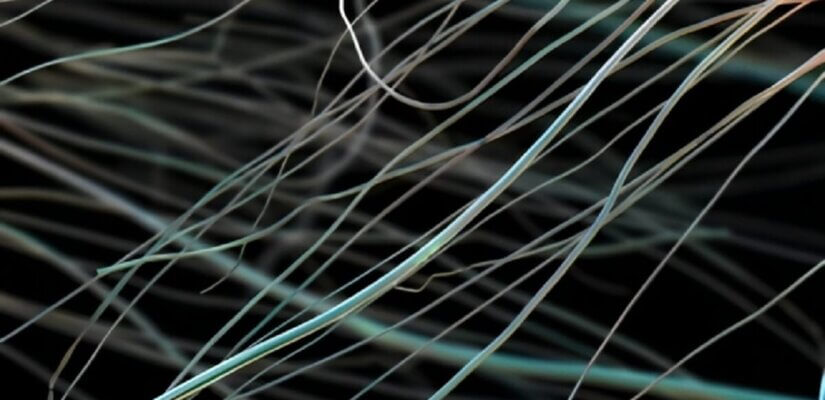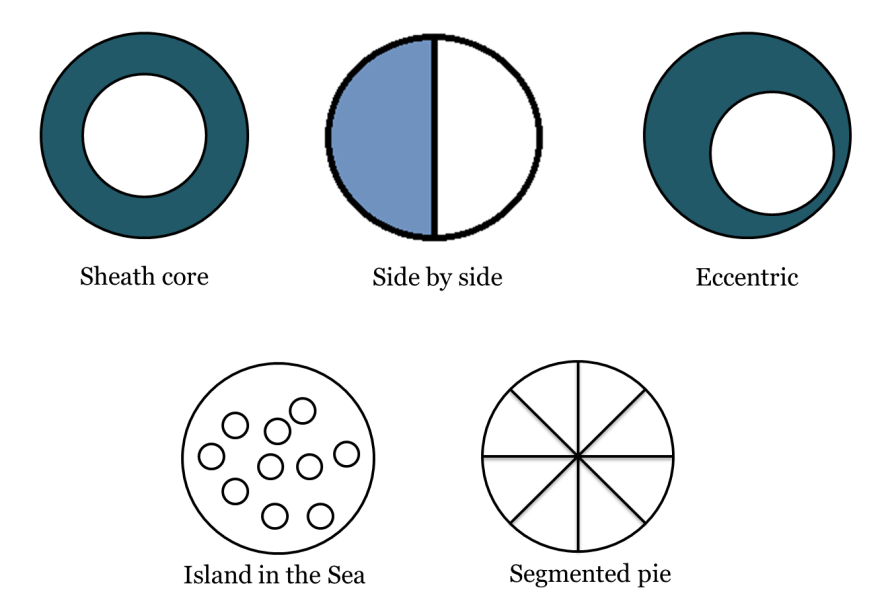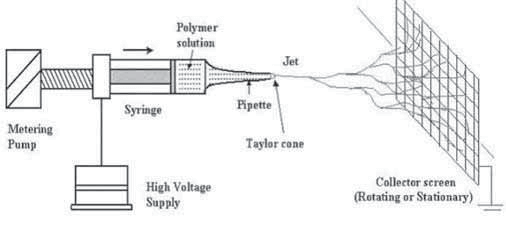
Diving into Nanofibers: Unlocking History & Manufacturing!
Welcome to our journey through the world of nanofibers! In this exciting exploration, we’ll uncover the fascinating history and advanced techniques behind these amazing materials. Join us as we discover the secrets of nanofibers and explore their incredible potential in different fields. From their beginnings to the latest discoveries, this blog will take you on an enlightening adventure through the evolution of nanofibers and the innovative ways they’re made. Let’s embark on this fascinating exploration together and unlock the amazing wonders of nanofibers.
Nanofibers:
Nanofibers have emerged as exciting one-dimensional (1D) nanomaterial’s for a wide range of research and commercial applications. The nanofibers can be made up of polymers that are natural, semi-synthetic and synthetic. The one nanometer is equal to 1×10-9.
History of nanofiber production:
The first nanofibers were produced by electrospinning more than four centuries ago. The work by William Gilbert (in 1600) was considered as an early example of what would become the modern electrospinning technology. Gilbert’s study is the first record of the electrostatic attraction of a liquid. In 1845, Louis Schwabe invented a number of methods for spinning silk and creating artificial fibers.
In 1902, the American inventor John Francis Cooley patented the first electrospinning device: “Apparatus for electrically dispersing fluids”. In 1912, Burton and Wiegand analyzed the effect of electricity on streams of water drops, and in 1914 John Zeleny studied the behavior of fluid droplets at the end of metal capillaries.
Between 1931 and 1944, Anton Formhals was granted at least 22 patents on electrospinning, including the first one (in 1934) on the experimental production of fibers. In 1938, Rozenblum and Petryanov-Sokolov generated electrospun fibers that they used to produce filter materials, known as “Petryanov filters”.
In 1952, Radushkevich and Lukyanovich produced hollow graphitic carbon fibers, and Oberlin, Endo, and Koyama (1976) developed a chemical vapor deposition (CVD) process to fabricate nanoscale carbon fibers. Between 1964 and 1969, Geoffrey Ingram Taylor established the theoretical foundation of electrospinning.
In 1966, Harold L. Simons patented an instrument to produce fiber fabrics with various patterns. The physicist Lord Rayleigh published several articles (1978-1979) on the influence of electricity on colliding water drops and the equilibrium of liquid conducting masses charged with electricity.
In 1987, Charles Vernon Boys described the spinning process in an article on glass fiber manufacture The modern term ‘electrospinning’ was popularized by Doshi and Reneker (1995) who produced fibers with a variety of cross-sectional shapes from different polymers from 50 nm to 5 µm microns in size. Since 1995, the number of publications on nanofibers has been increasing exponentially each year.
In 2001, Wang used electrospinning to fabricate inorganic fibers. In 2005, the first book on nanofibers (title: “An Introduction to Electrospinning and Nanofibers”) was published by Prof. Seeram Ramakrishna and co-author. In 2005, the Elmarco company developed NanospiderTM, the first technology in the world to enable the industrial scale production of nanofibers.
Currently, more than 200 universities and research institutes worldwide study various aspects of nanofiber production and their characteristics. More and more articles are published on new nanofiber fabrication techniques, and this trend does not seem to decline.
Indeed, using the keywords nanofibers, nanofibres, nanofiber or nanofibre, the SciFinder database of chemical literature identified 23,728 articles up to October 2018. About 85% of these articles were published from 2006 to 2023 and still continues.
Manufacturing techniques of nanofibers
There are a number of techniques capable of fabricating nanofibers. These techniques include component extrusion, phase separation, template synthesis, drawing, melt blowing, electrospinning and centrifugal spinning.

1. Bi-component extrusion (Island- in- the-sea)
Bicomponent fibers can be defined as extruding two polymers together in the same fiber from the same spinneret. Some examples of bi-component fibers include sheath-core, eccentric, islands-in-the-sea and Segmented pie fibers, as shown in Figure 1. Islands- in-the-sea form fibers are also called matrix-filament fibers because in cross section, they appear as one polymer is inserted into a matrix of a second polymer. Islands-in-the-sea fibers may have a uniform or non-uniform diameter of the island portion.
Essentially, these filaments are spun from the blend of two polymers in the required ratio; where one polymer is suspended as drops in the second’s melt. Fast cooling of the fiber beneath the spinneret holes is an important feature in fibers production. The differences in spinnability between the two polymers would almost hinder the spinnability of its blend, with the exception at lower mixtures concentration (#20%). One of the fiber components can be removed by the use of heat, a solvent or a chemical; or using mechanical devices.
In bi-component extrusion two polymers are delivered to a simple spinneret hole, split by a blade edge or septum, which feeds the two segments into side by side arrangements. The pipe in pipe method is one of most used methods to manufacture bi-component fibers where one of the streams constituent envelopes the other stream component at the end of the tube.

2. Phase Separation
In phase separation, a polymer is initially blended with a solvent before suffering gelation. The major mechanism in this system is the separation of phases owing to physical inconsistency. The solvent phase is then extracted, leaving the other residual phase. The phase separation method has involved main five steps, polymer dissolution, gelation, solvent extraction, freezing and freeze-drying.
3. Template Synthesis
Template synthesis is another commonly used approach mostly to produce inorganic nanofibers e.g. carbon nanotubes and nanofibers or conductive polymers like polyaniline (PANI), polypyrrole (PPy) etc.
Template synthesis involves the use of a template or mold to get a preferred material or structure. Thus the casting technique and DNA replication can be believed as template-based synthesis.
4. Drawing
The drawing process can be characterized as dry spinning at a molecular level. The process can only be applied to visco-elastic materials that can experience a high degree of deformations, but remaining sufficiently solid to hold up the developed stress during pulling.
A typical drawing method requires a SiO2 surface; a micro pipette and a micro manipulator to produce nanofibers. However, this process produced nanofibers in a laboratory-scale one by one which prevents it from being scaled up to industrial level.
A micropipette with a few micrometer diameters was dipped into the droplet near the contact line via a Micro manipulator. The micropipette was then removed from the liquor at a speed around 1 x 10-4 ms-1 to pull a nanofiber. The pulled fiber was dumped on the surface by touching it with the micropipette end.
The nanofiber drawing was frequently repeated on every droplet. The material viscosity at the edge of the droplet increased with evaporation. So, drawing a fiber involves a viscoelastic material which able to undergo strong deformations even as being adequate cohesive to maintain the developed stress during pulling.
5. Melt blown technology
Melt blown technology involves a single step production of fibers by a polymer melt extruding through an orifice die and drawing down the extrudate with a hot air, usually at similar temperature as the molten polymer. The air exerts the drag force to attenuate the melt extrudate into fibers, which are then gathered in the form of a nonwoven mat. This technique provides the utilization of thermoplastic polymers in a fairly economic spinning process as shown in below fig.

Melt blown technology
6. Electro spinning
Electro spinning is a famous procedure for the electrostatic production of polymer nanofibers. Formhals published the first patent for preparing artificial threads by electro spinning in 1934. Electro spinning is a smart method to attain nanofibers as it is simple to use and it produces non-woven mats with a wonderful volume/area ratio. The electro spinning techniques have two setup for generation of nanofibre. In the electro spinning technique, one is using needle based system and second needless. A jet of polymer solution is ejected from the tip of a droplet under electrostatic forces action. The produced nanofibers usually form a nonwoven mat. Individual nanofibre fragment of lengths up to several centimeters can be arranged and collected. The polymer solutions were located in a plastic syringe tip of inner diameter 0.6 mm. A pendant droplet of polymer solution was continued at the syringe tip.
Schematic of Electro spinning Setup.

Electrospinning by needle-based system

Electrospinning by needless system
The jet issued downs from the tip of the pendant drop of polymer solution and was attracted to the sharp frame of a collector disk revolving around a horizontal axis. The frame is placed at a distance of 200 mm below the droplet. The aluminum disk of 200 mm diameter had a pointed frame with a 26.60 half-angle, to create a stronger converging electrostatic field. Therefore an electric potential variation around (15- 40) KV was formed between the liquid drop surface and the rotating disk collector.
7. Centrifugal spinning
Electro spinning is definitely the preferred method for nanofibers fabrication; nevertheless it faces some drawbacks for instance high electric field necessities, solutions with superior dielectric properties, low production rate, high production cost and many other safety correlated topics, electro spinning could not be suitable for mass production of certain materials.
Centrifugal spinning, or Force spinning, is a recently developed nanofiber forming method and it draws extensive interest mainly due to its high production rate, which is 500 times faster than traditional Electro spinning.
Rather than using electrostatic force, centrifugal spinning develops centrifugal force to realize the high-rate production of nanofibers . Centrifugal spinning can be used to fabricate nanofibers by using polymer solutions or polymer melts, without the dielectric constant restrictions and the involvement of high voltage electric field. Besides, carbon, ceramic and metal fibers can also be fabricated by centrifugal spinning.
It is meaningful to note that the centrifugal spinning process was initially developed in 1924 by Hooper to produce artificial silk fiber from viscose by applying centrifugal forces to a viscous material. Therefore, this method has been used for fiber production since it was established by Hooper. The fiber formation process of centrifugal spinning relies upon the competition between centrifugal force and Laplace force (arise from surface curvature). During centrifugal spinning, the nanofiber formation process can be divided into three stages:
- Jet-initiation to force the polymer solution stream through the orifice,
- Jet-extension to enhance surface area of the forced polymer stream, and
- Solvent evaporation to harden and shrink the polymer jet.

Schematic drawing of Centrifugal spinning system
In the initial step, combinations of centrifugal and hydrostatic pressure at the capillary end exceed the Flow-resistant capillary forces and force the liquid polymer through the nozzle capillary as a jet.
The External radial centrifugal force stretches the polymer jet as it is anticipated toward the collector wall, but the jet moves in a warped curve owing to rotation-dependent inertia.
Stretching of the extruded polymer jet is significant in jet diameter reduction over the distance from the nozzle to the collector. At the same time, the solvent in the polymer solution evaporates, solidify and contract the jet. The solvent evaporation rate depends on its stability.
For highly volatile solvent the jets form thicker fiber as the fast evaporating potentiates fast solidification which hinders the jet extension.
With respect to centrifugal spinning, parameters that impact the spinning process and the structure of the resultant nanofibers include spinneret angular velocity, orifice radius, polymer viscoelasticity, solution surface tension, solvent evaporation rate, temperature and the nozzle-collector distance .
References:
1. Nalwa, H. S. Handbook of nanostructured materials and nanotechnology, Academic press, San Diego, (2000).
2. KO, F. K. and Wan, Y. Introduction to Nanofiber Materials. Cambridge University Press, United Kingdom, (2014).
3. Laurencin, C. T. and Nair, L. S. Polyphosphazene Nanofibers for Biomedical Applications: Preliminary studies. Nanoengineered Nanofibrous Materials Series: Nato Science Series II, Mathematics, Physics and Chemistry, 283-302, (2004).
4. Krupk, R., Hennrich F., Löhneysen H. V. and Kappes M. M. Separation of Metallic from Semiconducting Single Walled Carbon Tubes. Science, 301 (5631), 344-347, (2003).
5. Ramakrishna, S., Fujihara, K., Teo, W.-E., Lim, T.-C. and Ma, Z. An introduction to
electrospinning and nanofibers. World Scientific Publishing Co. Pte. Ltd, USA, (2015).
6. Hagewood, J. F. Polymeric Nanofibers – Fantasy or Future?. Technical Textile Technology, 1(1), (2002).
7. Hegde, R. R., Dahiya, A. and Kamath, M. G. Bicomponent Fibers, May (2006) http://
www.engr.utk.edu/mse/pages/Te x t i l e s / Bicomponent% 20fibers.htm.
8. Fitzgerald, W. E. and Knudsen, J. P. Mixed-stream spinning of bicomponent fibers, Textile Research Journal, 37 (6), 447-453, (1967).
9. Lewin, M. and Sello, S. B. Handbook of Fiber Science and Technology, New York, M. Dekker,
(1985).
10. Nakata K., Fujii K., Ohkoshi Y., Gotoh Y., Nagura M., Numata M. and Kamiyama M., Poly (ethylene terephthalate) nanofibers made by sea-islandtype conjugated melt spinning and laser-heated flow drawing. Macromolecular Rapid Communications, 28 (6), 792-795, (2007).
11. Ma, P. X. and Zhang, R. Synthetic nano-scale fibrous extracellular matrix. J. Biomed. Mater.
Res., 46 (1), 60-72, (1999).
12. Yang, H. F., Yan, Y. and Liu, Y. A Simple melt impregnation method to synthesize ordered
mesoporous carbon and carbon nanofiber bundles with graphitized structure from pitches. Journal of Physical Chemistry B, 108 (45), 17320 – 17328, (2004).
13. Li, X., , Tian S, Ping Y, Kim DH, and Knoll W.,One-step route to the fabrication of highly
porous polyaniline nanofiber films by using PSb- PVP diblock copolymers as templates, Langmuir, 21 (3), 9393-7, (2005).
14. Feng, L., Li, S., Li, H., Zhai, J., Song, Y., Jiang, L. and Zhu, D. Super hydrophobic surface of
aligned polyacrylonitrile nanoflbers. Angew. Chem., 114 (7), 1269-1271, (2002).
15 . Jayaraman K., Kotaki, M., Zhang Y., Mo X. and Ramakrishna, S. Recent advances in polymer nanofibers. Journal of Nanoscience and
Nanotechnology, 4 (2), 52 -65, (2004).
16. Ondarçuhu, T. and Joachim, C. Drawing a singlenanofibre over hundreds of microns. Europhysicsletters, 42 (2), 215-220, (1998)
17. Hassan M.A., Yeom B. Y., Wilkie A., PourdeyhimiB., Khan S. A., Fabrication of nanofibermeltblown membranes and their filtration properties.Journal of Membrane Science,427, 336-344,(2013).
18. Huang Z. -M., Zhang Y.-Z., Kotaki M.,Ramakrishna S. A review on polymer nanofibersby electrospinning and their applications innanocomposites. Composites Science and Technology63, 2223-2253, (2003).
19. Bognitzki, M., Czado, W., Frese, T., Schaper A.,Hellwig M., Steinhart M., Greiner A. and WendorffJ. H., Nanostructrured Fibers Via Electrospinning.Adv. Mater., 13, 70-72, (2001).
20. Formhals, A. Process and Apparatus for PreparingArtificial Threads. US Patent 1, 975, 504,(1934).
21. Reneker, D. H. and Chun, I. Nanometre diameterfibres of polymer, produced by electrospinning.Nanotechnology, 7, 216 -223, (1996).
22. Wang, X., Ding, B., Sun, G., Wang, M. and Yu,J. Electro-spinning/netting: A strategy for the fabricationof three-dimensional polymer nano-fiber/nets. Progress in Materials Science, 58, 1173-1243, (2013).
23. Forward, K. M., Flores, A. and Rutledge, G. C.Production of core/shell fibers by electrospinningfrom a free surface. Chemical Engineering Science,104, 250-259, (2013).
24. Subbiah, T., Bhat, G. S., Tock, R. W.,Parameswaran, S. and Ramkumar, S.
Electrospinning of nanofibers. Journal of AppliedPolymer Science, 96 (2), 557-569, (2005).
25. Theron, A., Zussman, E. and yarin, A. L. Electrostatic field-assisted alignment of electrospun
nanofibres. Nanotechnology, 12, 384-390, (2001).
26. Zussman, E., Rittel, D. and yarin, A. L. Failuremodes of elecrtospun fibers, Applied PhysicsLetters, 82 (22), 3958-3960, (2003).
27. Zhang, X. and Lu, Y. Centrifugal Spinning: Analternative approach to fabricate nanofibers at highspeed and low Cost. Polymer Reviews, 54 (4),677- 701, 2014.
28. Souza, M. A., Oliveira, J. E., Medeiros, E. S.,Glenn, G. M. and Mattoso, L. H. C. Controlled
release of linalool using nanofibrous membranesof poly (lactic acid) obtained by electrospinning
and solution Blow aspinning: A comparative study. Journal of nanoscience and nanotechnology, 15(8), 5628-5636, 2015.
29. Balogh, A., Farkas, B., Farago, K., Farkas, A. Wagner, I., Van, A. I., Verreck, G., Nagy, Z. K.and Marosi, G. Melt-blown and electrospun drugloadedpolymer fiber mats for dissolution enhancement:A comparative study. Journal of pharmaceuticalsciences, 104 (5), 1767-1776, (2015).
30. Chen W., Liu, Y., Ma, Y., Liu, J., Liu, X. Improvedperformance of PVdF-HFP/PI nanofiber
membrane for lithium ion battery separator preparedby a bicomponent cross-electrospinning
method. Materials Letters, 133, 67-70, (2014).
31. Ren, L., Ozisik, R. and Kotha, S. P. Rapid andefficient fabrication of multilevel structured silicamicro-/nanofibers by centrifugal jet spinning.Journal of Colloid and Interface Science, 425,136-142, (2014).
32. Padron, S., Fuentes, A., Caruntu, D. and Lozano,K. Experimental study of nanofiber productionthrough forcespinning. Journal of Applied Physics,113, 1-9, (2013).